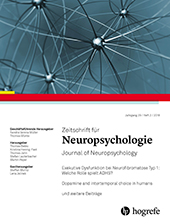Androgene verändern die Hirnantworten auf sexuelle Stimuli bei Frau-zu-Mann-Transsexuellen: eine fMRT Studie
An fMRI study
Abstract
Abstract. Interpersonal and intrapersonal differences in brain responses to sexual stimuli have been linked with individuals’ testosterone levels. However, it remains unclear how hormones modulate brain functions underlying sexual arousal. In order to assess the effects of chronic hormonal treatment, we used functional magnetic resonance imaging in a group of female-to-male transsexuals before and during androgen therapy while they watched a set of pictures representing dressed or nude (erotic content) men or women (sex information). A broad network of cortical and subcortical regions were activated during the processing of erotic stimuli (nude vs. dressed), including the insula, amygdala, and hypothalamus. The insula activity in response to erotic male stimuli decreased over the initial 4 months of hormonal therapy. In the following 8 months, the insula response to erotic female stimuli increased. In other words, long-term androgen administration makes the brain more “male” by reducing the sexual arousal caused by male stimuli and amplifying that caused by female stimuli.
Zusammenfassung. Interpersonelle und intrapersonelle Unterschiede in der neuralen Reaktion auf sexuelle Stimuli sind mit dem individuellen Testosteron-Spiegel in Verbindung gebracht worden. Um die Effekte einer chronischen Hormonbehandlung zu erfassen, haben wir in dieser Studie Frau-zu-Mann-Transsexuelle vor und während einer Androgentherapie untersucht, die erotische und nicht erotische Bilder im fMRT betrachteten. Ein weit verteiltes Netzwerk von kortikalen und subkortikalen Regionen einschließlich Insel, Amygdala und Hypothalamus wurde während der Verarbeitung von erotischer Information (unbekleidet/bekleidet) aktiviert. Die neurale Antwort auf erotische männliche Stimuli nahm infolge der Hormontherapie ab, die auf weibliche Stimuli hingegen zu. Somit macht eine Langzeithormontherapie mit Testosteron „männlicher“, indem die Antwort auf männliche Stimuli erhöht und auf weibliche Stimuli erniedrigt wird.
Literature
(2006). Effect of estradiol versus estradiol and testosterone on brain-activation patterns in postmenopausal women. Menopause, 13, 528–537.
(2002). Brain activation and sexual arousal in healthy, heterosexual males. Brain 125, 1014–1023.
(1996). Circuitry and functional aspects of the insular lobe in primates including humans. Brain Research Reviews, 22, 229–244.
(2008). Does it look painful or disgusting? Ask your parietal and cingulate cortex. Journal of Neuroscience, 28, 923–931.
(2006). Neural correlates of social and nonsocial emotions: An fMRI study. NeuroImage, 31, 397–409.
(2008). Hypothalamus, sexual arousal and psychosexual identity in human males: a functional magnetic resonance imaging study. Eur J Neurosci. 2008 Jun;27(11):2922–7.
(2006). Predictability modulates the affective and sensory-discriminative neural processing of pain. NeuroImage, 32, 1804–1814.
(2010). Cortical activation during mental rotation in male-to-female and female-to-male transsexuals under hormonal treatment. Psychoneuroendocrinology, 35, 1213–1222.
(1999). Transsexualism: A review of etiology, diagnosis and treatment. Journal of Psychosomatic Research, 46, 315–333.
(2008). Understanding the emotional expression of verbal interjections: A functional MRI study. NeuroReport, 19, 1751–1755.
(2005). Dynamics of male sexual arousal: Distinct components of brain activation revealed by fMRI. NeuroImage, 26, 1086–1096.
(2009). Modulation of alpha oscillations in insular cortex reflects the threat of painful stimuli. NeuroImage, 46, 1082–1090.
(2005). Human brain activation during sexual stimulation of the penis. The Journal of Comparative Neurology, 493, 33–38.
(2006). There are differences in cerebral activation between females in distinct menstrual phases during viewing of erotic stimuli: A fMRI study. Experimental Brain Research, 174, 101–108.
(1998). Cross-modal transfer of information between the tactile and the visual representations in the human brain: A positron emission tomographic study. Journal of Neuroscience, 18, 1072–1084.
(2004). Men and women differ in amygdala response to visual sexual stimuli. Nature Neuroscience, 7, 411–416.
(2002). Areas of brain activation in males and females during viewing of erotic film excerpts. Human Brain Mapping, 16, 1–13.
(2006). Brain activation by visual erotic stimuli in healthy middle aged males. International Journal of Impotence Research, 18, 452–457.
(2000). Selective influence of the menstrual cycle on perception of stimuli with reproductive significance: An event-related potential study. Psychophysiology, 37, 111–122.
(2009). Why we haven’t died out yet: Changes in women’s mimic reactions to visual erotic stimuli during their menstrual cycles. Hormones and Behavior, 55, 267–271.
(2010). Affective response to a loved one’s pain: Insula activity as a function of individual differences. PLoS One, 5, e
15268 .(2006). Neuroanatomical correlates of penile erection evoked by photographic stimuli in human males. NeuroImage, 33, 689–699.
(2003). Brain processing of visual sexual stimuli in healty men: A functional magnetic resonance imaging study. NeuroImage, 20, 855–869.
(1992). Cardiovascular effects of human insular cortex stimulation. Neurology, 42, 1727–1732.
(2001). A new potential of blood oxygenation level dependent (BOLD) functional MRI for evaluating cerebral centers of penile erection. International Journal of Impotence Research, 13, 73–81.
(2008). Brain response to visual sexual stimuli in heterosexual and homosexual males. Human Brain Mapping, 29, 726–735.
(2006). A functional endophenotype for sexual orientation in humans. NeuroImage, 33, 825–833.
(2000). Brain processing of visual sexual stimuli in human males. Human Brain Mapping, 11, 162–177.
(2008). Warm pleasant feelings in the brain. NeuroImage, 41, 1504–1513.
(2009). Neural activation in the orbitofrontal cortex in response to male faces increases during the follicular phase. Hormone and Behavior, 56, 66–72.
(2009). Brain structures activated by overt and covert emotional visual stimuli. Brain Research Bulletin, 79, 258–264.
(2007). Individual differences in the effects of perceived controllability on pain perception: Cortical role of the prefrontal cortex. Journal of Cognitive Neuroscience, 19, 993–1003.
(2010). Neuroimaging differences in spatial cognition between men and male-to-female transsexuals before and during hormone therapy. Journal of Sexual Medicine, 7, 1858–1867.
(2007). A comment on the severity of the effects of non-white noise in fMRI-series. NeuroImage, 36, 282–288.
(1999). Neuroanatomical correlates of visually evoked sexual arousal in human males. Archives of Sexual Behavior, 28, 1–21.
(2008). Distinguishing specific sexual and general emotional effects in fMRI-Subcortical and cortical arousal during erotic picture viewing. NeuroImage, 40, 1482–1494.
(2011). Androgens modulate neural mechanisms of empathetic processes in female-to-male transsexuals: An fMRI study. Zeitschrift für Neuropsychologie, 22, 263–277.



